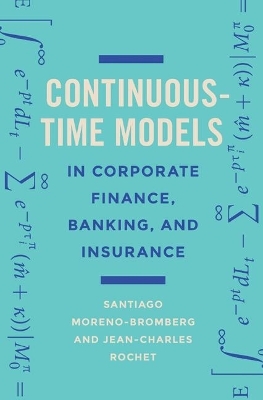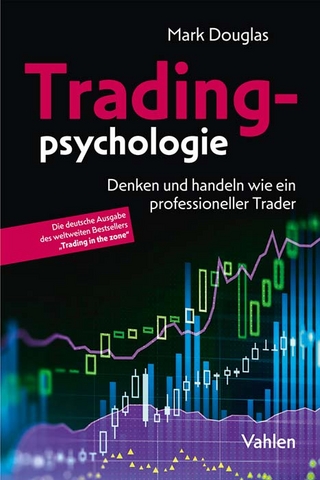
Continuous-Time Models in Corporate Finance, Banking, and Insurance
Princeton University Press (Verlag)
978-0-691-17652-9 (ISBN)
The book concludes by presenting the dynamic agency model, where financial frictions stem from the lack of interest alignment between a firm's manager and its financiers. The appendix contains an overview of the main mathematical tools used throughout the book. Requiring some familiarity with stochastic calculus methods, Continuous-Time Models in Corporate Finance will be useful for students, researchers, and professionals who want to develop dynamic models of firms' financial decisions.
Santiago Moreno-Bromberg is senior research associate in the Center for Finance and Insurance at the University of Zurich. Jean-Charles Rochet is professor of banking at the University of Zurich, senior chair and head of research at the Swiss Finance Institute, and research director at the Toulouse School of Economics.
Preface xiIntroduction 11 Why Is Option Pricing Useful in Corporate Finance? 71.1 Modeling assumptions 71.2 Pricing corporate debt 91.3 Endogenous default date 111.3.1 The general form of the valuation equation 111.3.2 The price of a consol bond 131.4 Dynamic trade-off theory 151.4.1 Taxes and liquidation costs 161.4.2 Asset pricing 161.4.3 Financial decisions 191.4.4 Testable predictions 21 1.5 Further reading 222 The Base Liquidity-Management Model 262.1 The dynamics of net earnings 262.2 Risk-averse shareholders 272.2.1 Shareholder value 282.2.2 The optimal dividend flow 302.2.3 The value function 312.3 Risk-neutral shareholders 332.3.1 The dynamics of liquid reserves and the value function 342.3.2 The optimal dividend-distribution strategy 382.3.3 Economic implications 412.4 Further reading 423 Equity Issuance 453.1 Fixed issuance cost and stock-price dynamics 453.1.1 Optimal equity issuance with a fixed issuance cost 463.1.2 The impact of equity-issuance on the value function 483.1.3 When is equity issuance too costly? 503.1.4 Stock-price dynamics 513.2 Proportional issuance cost 533.2.1 The value function with a proportional issuance cost 543.2.2 Characterizing the optimal dividend-distribution barrier 543.2.3 The optimal equity-issuance strategy when the issuance cost is proportional 563.3 Uncertain refinancing opportunities 573.3.1 The cash-reserves dynamics with uncertain refinancing 573.3.2 The amount of uncertain refnancing 583.3.3 The refinancing region and the target cash level 603.4 Further reading 614 Applications to Banking 634.1 A simple continuous-time model of a bank 634.1.1 The model 634.1.2 The impact of a minimum-capital requirement 644.1.3 A minimum-capital requirement with recapitalization 664.2 A bank's portfolio problem 674.2.1 Setting up the stochastic-control problem 684.2.2 The value function and the first-best 694.3 Optimal bank funding 744.3.1 The model 744.3.2 The optimal funding strategies 774.3.3 Numerical analysis 804.4 Further reading 815 Applications to Insurance 845.1 The base liquidity-management model with large losses 845.1.1 The variational inequality in the presence of large losses 855.1.2 The value function 855.1.3 Computing the value function 885.2 Reinsuring Brownian risks 895.2.1 The dynamics of liquid reserves and the variational inequality 905.2.2 The partial-exposure region 915.2.3 The full-exposure region 935.2.4 Sensitivity analysis 945.3 Reinsuring large losses 965.3.1 The cash-reserves dynamics 965.3.2 The optimal reinsurance strategy 975.4 Further reading 986 Applications to Investment 1016.1 The /q-model" of corporate investment 1016.1.1 The stock of capital and its productivity 1026.1.2 Shareholder value 1036.1.3 Tobin's q 1036.2 Introducing external financial frictions 1056.2.1 The impact of liquidity constraints on firm value 1066.2.2 The size-adjusted value function 1076.2.3 Optimal investment and Tobin's q 1096.3 Adopting a new technology 1106.3.1 The model 1106.3.2 The interaction between investment and dividend payouts 1116.3.3 The optimal investment time 1136.4 Further reading 1157 Agency Frictions 1177.1 Asset substitution and capital structure 1177.1.1 The model 1187.1.2 The risk-shifting problem 1197.1.3 The impact of risk shifting on firm value 1207.2 Dynamic capital structure 1217.2.1 The model 1217.2.2 The manager's continuation utility 1237.2.3 The principal's value function and the optimal contract 1247.2.4 Implementing the optimal contract through the firm's capital structure 1277.3 Preventing large risks 1307.3.1 The model 1307.3.2 The contracting problem 1317.3.3 Addressing incentive compatibility 1327.3.4 The financiers' value function 1337.3.5 The size-adjusted problem and the optimal contract 1357.4 Further reading 1378 Equilibrium Models 1408.1 The Brunnermeier-Sannikov model 1408.1.1 The model 1408.1.2 The value function of a financial intermediary 1428.1.3 The value function of households and the competitive equilibrium 1448.2 An equilibrium version of the base model 1468.2.1 The model 1468.2.2 Equilibrium 1498.2.3 The long-term behavior of the economy 1508.3 Insurance cycles 1528.3.1 The model 1538.3.2 Equilibrium 1558.3.3 Dynamics of insurance prices 1608.4 Further reading 161Appendix A Proofs of Main Results and Technical Complements 163A.1 Chapter 1 163A.2 Chapter 2 164A.3 Chapter 3 169A.4 Chapter 4 173A.5 Chapter 5 178A.6 Chapter 7 180A.7 Chapter 8 183Appendix B The Modigliani-Miller Theorem 185Appendix C Useful Mathematical Results 188C.1 Filtrations, Martingales and It^o Processes 188C.2 The It^o Formula 192C.3 The Martingale Representation Theorem(s) 195C.4 The Optimal Sampling Theorem 196References 206Index 207
| Erscheinungsdatum | 03.02.2018 |
|---|---|
| Zusatzinfo | 15 line illus. |
| Verlagsort | New Jersey |
| Sprache | englisch |
| Maße | 152 x 229 mm |
| Gewicht | 510 g |
| Themenwelt | Wirtschaft ► Betriebswirtschaft / Management ► Finanzierung |
| Betriebswirtschaft / Management ► Spezielle Betriebswirtschaftslehre ► Bankbetriebslehre | |
| Wirtschaft ► Volkswirtschaftslehre ► Ökonometrie | |
| ISBN-10 | 0-691-17652-3 / 0691176523 |
| ISBN-13 | 978-0-691-17652-9 / 9780691176529 |
| Zustand | Neuware |
| Haben Sie eine Frage zum Produkt? |
aus dem Bereich


